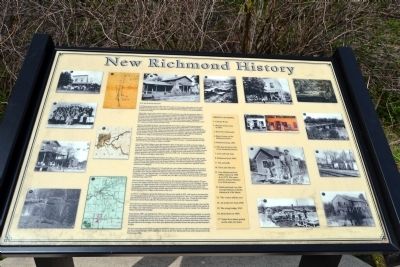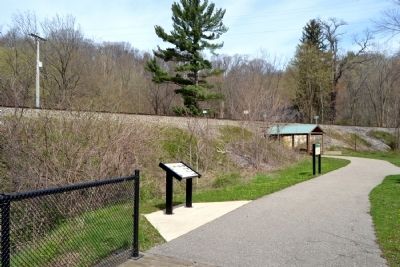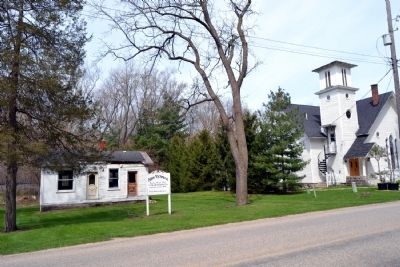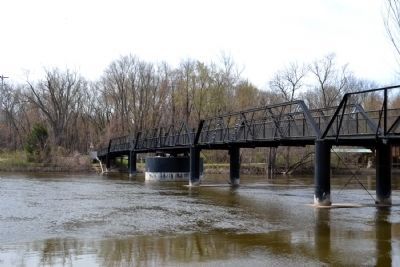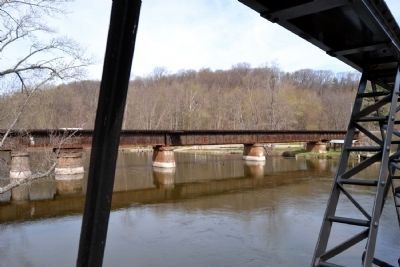Near Fennville in Allegan County, Michigan — The American Midwest (Great Lakes)
New Richmond History
New Richmond got its start in 1836, when three eastern investors, led by John Allen of Ann Arbor, arranged to found a city here. John Allen, a Virginian by birth, purchased 2240 acres in Allegan County on the north side of the Kalamazoo River just west of its confluence with the Rabbit River in Manlius Township.
Allen’s plan was for a town whose existence would be based on saw mills. He platted the village of “Richmond”, after his home town of Richmond, Virginia. The village was originally platted just a bit north and west of the present location. Elaborate maps were printed by Allen in 1836, hoping to use them to attract prospective investors and settlers. After some land was cleared, a general store and some houses were built and in November 1837, a post office open named “Richmond”. (After Allen’s business venture failed in 1838 due to financial depression following the Panic of 1837, this original post office closed in October 1839).
Then in 1844, Ralph R. Mann, who had originally been hired by Allen to direct improvements at Richmond, moved a mile and a half south along what was later called Mann Creek and built a water-powered sawmill on the river, damming the creek and creating a long narrow mill pond. On the northeast end of the pond, Johnson Parsons built a store, John Roe opened a tavern and Randall Curtis started a tannery. This settlement became known as “Manlius” and a post office opened there in July of 1846. Curtis also became the first postmaster of Manlius in 1846. Mail was received at Manlius from Allegan and dispatched from there on the mouth of the river.
In 1851, E.A. Fenn, who would later found the city of Fennville, arrived from the east. For his first Michigan home, Fenn chose land near the village of Manlius because, “it seemed desirable to located near as lively and promising a village as Manlius.”
One of the earliest bridges to span the Kalamazoo River at this point was built in 1842 by Ralph R. Mann. This was a wooden bridge that was later replaced in 1879 by an iron swing bridge, which you see here today. This iron bridge was designed to have the center span pivot to allow riverboat traffic up and down the Kalamazoo and operated in this capacity until the 1920's. The iron bridge was open until 1997, when it was closed to vehicular traffic. In 2005 the iron swing bridge was restored to its original splendor and it was re-opened to pedestrian traffic only. It now serves as the centerpiece t the New Richmond Bridge County Park.
When the railroad passed through Manlius Township in 1871 it ran parallel to Mann Creek and the millpond and a depot was built near the settlement, on the west side of the creek. For a while, Manlius
was a station on the Chicago and North Western Railway. The railroad stopped there through the summer in 1878, although at certain times of the year only one train stopped there regularly and all others had to be flagged.
With the coming of the railroad, H.F. Marsh laid out a new village of Richmond just to the south of the original site. The new community prospered and after a time supplanted Manlius in importance. In October 1872, the post office in Manlius was closed and another was established in the new settlement. However, because there was already a Richmond in Michigan the name of this settlement was changed to “New Richmond”. Eventually the post office was moved to the Lamoureux store and remained opened until 1979.
After the demise of Manlius, New Richmond became the principal railroad station and for 25 years served as the supply point for all the county along the river between there and Lake Michigan. The site was chosen as a station because of its convenience to Saugatuck and Douglas and as soon as the railroad was completed in 1871, postal and passenger communication was opened between these points and established a connection that lasted until the interurban line from Holland to Saugatuck gave a quicker means of access to the villages at the mouth of the river.
In 1871, E.J. Wheelock opened the Richmond House in 1871, with rooms to
accommodate over 30 guests. A dry goods store was opened at about the same time by Capt. A.H. Coates, and another general store started by N.J. Sherman opened in September of the same year. Marsh had also built a store and a second hotel called the Western Hotel which was run by the Lamoureux family.
Over time two taverns were opened in New Richmond. Gilbert Lamoureux opened another store and the business activity of the hamlet increased. The stage coaches that ran to Saugatuck added to the activity in the village, and with lumbering and an increasing fruit farming industry in the vicinity, New Richmond enjoyed considerable prestige.
From the late 1800's up until the late 1920's or so, New Richmond continued to gain popularity as a tourist destination, at one point having as many as four hotels. Steamboat service was available to Saugatuck and Douglas and daily stagecoach service was available to Holland. A series of fires occurred during those years, burning the sawmills and several of the hotels. At some point, little else remained other than a few houses, the post office and the bridges. Over time, New Richmond gradually became the quiet, peaceful location it is today.
The last remaining hotel which was abandoned for a number of years, is still standing and was purchased and renovated in the late 1990's and is now known as the New Richmond House
and is located next to the former post office.
Topics and series. This historical marker is listed in these topic lists: Bridges & Viaducts • Industry & Commerce • Railroads & Streetcars • Settlements & Settlers. In addition, it is included in the Postal Mail and Philately series list. A significant historical month for this entry is July 1846.
Location. 42° 39.127′ N, 86° 6.418′ W. Marker is near Fennville, Michigan, in Allegan County. Marker can be reached from Old Allegan Road, 0.3 miles east of 58th Street. Marker is located near the north entrance to New Richmond Bridge County Park. Touch for map. Marker is in this post office area: Fennville MI 49408, United States of America. Touch for directions.
Other nearby markers. At least 8 other markers are within 5 miles of this marker, measured as the crow flies. Fifty-Seventh Street Bridge (a few steps from this marker); The Railroad & New Richmond (within shouting distance of this marker); New Richmond Historical Timeline (about 400 feet away, measured in a direct line); The Allegan Road (approx. 3.9 miles away); Welcome to River Bluff Park (approx. 3.9 miles away); Welcome to Fennville (approx. 4 miles away); All Saints Episcopal Church / Gordon W. Lloyd (approx. 4.8 miles away); First Congregational Church (approx. 4.9 miles away). Touch for a list and map of all markers in Fennville.
More about this marker. The marker includes several historic photographs and illustrations: (1) Chicago House; (2) Manlius School class of 1894; (3) Hotel New Richmond; (4) Basket barge on the Kalamazoo River; (5) Richmond Map, 1836; (6) Old map found in wall of an abandoned house; (7) Area railroad map; (8) Richmond post office; (9) The sawmills; (10) The Lake Side Inn; (11) New Richmond Post Office shown in 1958 & in 1975. The same person, Jennie Slotman is in both pictures; (12) Railroad hand car with George Pamerex, Charles Johnson & a Mr. Bunty; (13) The veneer mill & crew; (14) An aerial view from 1950; (15) The swing bridge, 1915; (16) Downtown in 1960; and (17) Notice of a dance posted on the side of a barn.
Also see . . .
1. New Richmond Bridge County Park. Allagan County website entry (Submitted on May 9, 2014.)
2. New Richmond Bridge / 57th Street Bridge. From the HistoricBridges.org website. (Submitted on May 9, 2014.)
Credits. This page was last revised on April 5, 2022. It was originally submitted on May 9, 2014, by Duane Hall of Abilene, Texas. This page has been viewed 867 times since then and 86 times this year. Photos: 1, 2, 3, 4, 5. submitted on May 9, 2014, by Duane Hall of Abilene, Texas.
